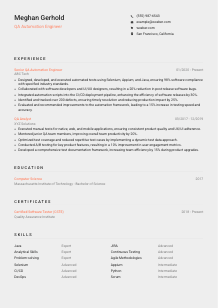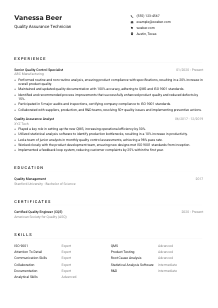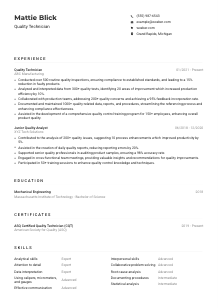QA Automation Engineer Resume Example
Squashing bugs, but your resume feels glitchy? Leap into this QA Automation Engineer resume example, streamlined with Wozber free resume builder. Learn how to code your quality assurance expertise to mirror job expectations, so your career journey runs as smoothly as a well-designed user interface!

How to write a QA Automation Engineer resume?
Ahoy, future QA Automation Engineer! In the realm of software development, where the smallest bug can cast the longest shadow, your role is nothing short of a superhero. But even superheroes need to prove their mettle. The first battleground? Your resume.
Fear not, for the Wozber free resume builder is the sidekick you didn't know you needed, armed with ATS-friendly resume templates and an ATS resume scanner. This guide is tailor-made to ensure your resume not only strikes a chord with hiring managers but does so with a tune that's music to the ears of the ATS. Ready to dive in? Let's code your way to an interview!
Personal Details
Before your resume starts tackling algorithms and impressing hiring managers, it needs to introduce you – and not just your name, but your aspiration to thrive as a QA Automation Engineer. Here's how to make your personal details section more than just an introduction - but a bold declaration of intent.
1. The Name Game
Your name is your headline, so let it shine in a font that's clear and bold, instantly grabbing attention. Think of it as the title of your professional saga.
2. Title in Focus
Immediately under your name, echo the role you're applying for - "QA Automation Engineer". It's like telling the ATS, "Yes, I am who you're looking for."
3. Connect with Me
List your contact details clearly - phone number and professional email are must-haves. A pro tip: Check that your email reflects your professionalism. Batman wouldn't use a batkid123 email, would he?
4. Location, Location, Location
Mentioning "San Francisco, California" as your location hits the geographical checkbox many companies consider for logistics or legal reasons. If you're exactly where the job is, you're already ticking boxes.
5. A URL to Your Universe
If you have a LinkedIn profile or a personal website showcasing your projects and accomplishments, include it. Make sure it's a mirror reflection of your resume, reinforcing your expertise and achievements.
Takeaway
Each detail in your personal information section sets a foundational stone for your professional narrative. Crafted carefully, it can speak volumes before the hiring manager even moves on to your experiences. This is your chance to make a strong, personal connection right off the bat.





Experience
This section is where you transform from a name on a paper into a QA Automation Engineer extraordinaire. It's about demonstrating - with precision and clarity - how your journey aligns perfectly with the role at hand.
- Designed, developed, and executed automated tests using Selenium, Appium, and Java, ensuring 98% software compliance with specified industry standards.
- Collaborated with software developers and UI/UX designers, resulting in a 20% reduction in post‑release software bugs.
- Integrated automation scripts into the CI/CD deployment pipeline, enhancing the efficiency of software releases by 30%.
- Identified and tracked over 200 defects, ensuring timely resolution and reducing production impact by 25%.
- Evaluated and recommended improvements to the automation framework, leading to a 15% increase in testing speed and accuracy.
- Executed manual tests for native, web, and mobile applications, ensuring consistent product quality and UX/UI adherence.
- Mentored junior QA team members, improving overall team productivity by 20%.
- Optimized test coverage and reduced repetitive test cases by implementing a dynamic test data approach.
- Conducted A/B testing for key product features, resulting in a 10% improvement in user engagement metrics.
- Developed a comprehensive test documentation framework, increasing team efficiency by 15% during product upgrades.
1. Decipher the Code
Align your experience bullets with phrases from the job description. Did you "design, develop, and execute automated tests using Selenium"? If it's in the job ad and in your job history, it needs to be on your resume—clear and direct.
2. Framework of Your Saga
List each role chronologically, starting with the most recent. Position titles, companies, and dates of employment set the stage for the stories of your achievements to follow.
3. Achievements in Action
For every role, succinctly describe how you made an impact. Use active language and match the responsibilities and triumphs to those sought by the employer, like integrating automation scripts into the CI/CD pipeline.
4. Quantify Your Quests
Numbers speak louder than adjectives. Did your efforts increase testing efficiency by 30%? Quantifying your achievements paints a vivid picture of your capabilities and results.
5. Relevance is Key
While your stint as a summer camp leader might have honed your leadership skills, keep the focus here on your QA Automation Engineering feats. Relevance makes your resume a laser-guided missile, not a scattergun.
Takeaway
When tailored precisely, your experience section not only reflects your suitability but screams 'perfect match'. It's about painting yourself as the solution to the employer's needs, one bullet point at a time. Be the protagonist in your professional story that the hiring manager can't wait to meet.
Education
While dazzling with your experience takes center stage, your education section provides the backdrop of your technical competence and intellectual rigor. It's where you showcase the roots of your expertise.
1. Match the Blueprint
Start by ensuring your highest degree aligns with the job requirements. The employer seeks "Bachelor's degree in Computer Science, Engineering, or related field." If that's you, make it known.
2. Layout the Landmarks
Keep this section simple yet informative. Present your degree, the name of the university, and your graduation year. This builds a timeline, rooting your professional journey in a strong educational foundation.
3. Detail the Design
If your degree directly matches the employer's requirements, like a "Bachelor of Science in Computer Science," ensure it's highlighted. This immediate match can be a green light for the ATS and the hiring manager.
4. Architectural Additions
For those early in their career or in highly specialized roles, adding relevant coursework or projects can bolster your qualifications, especially if they tie directly back to the job, like a major project using Selenium.
5. Erecting Educational Milestones
Graduating cum laude or engaging in notable academic projects can add layers to your candidacy, showcasing dedication and proficiency. Though, weigh the relevance based on your career stage.
Takeaway
Your educational background isn't just about where you've studied; it's a testament to your foundational knowledge and your journey of becoming a QA Automation Engineer. Showcase it as a proud part of your narrative, aligning it closely with your dream role's demands.
Certificates
In the tech world, where today's innovation can become tomorrow's standard, continuous learning is your superpower. Certificates are tangible evidence of your commitment to staying at the bleeding edge of QA automation.
1. Sync with the Specs
The job posting for the QA Automation Engineer may not specify required certifications, but including pertinent ones like "Certified Software Tester (CSTE)" immediately signals your dedication and expertise.
2. Selectiveness Shines
A precise list of relevant certifications trumps a long list of unrelated accolades. Prioritize those that match the job description or elevate your stature in the QA Automation sphere.
3. Timeliness Tells Tales
Inlude the acquisition or expiry dates for certifications to show your updates in the field. Nobody wants to hire a knight wielding outdated armor, no matter how shiny.
4. Upgrade and Update
The tech landscape is always shifting. Showing that you're not just keeping up but actively mastering new tools and methodologies via certifications can place you a step ahead of the competition.
Takeaway
In a field that evolves by the nanosecond, your certificates are proof of your prowess and pursuit of excellence. Highlight them not just as accolades, but as evidence of your relentless drive to remain at the forefront of QA Automation Engineering.
Skills
In the narrative of your QA Automation Engineer resume, 'Skills' is where you flaunt your professional toolkit. This section should not only resonate with the job description but also make the hiring manager nod in approval.
1. Unearth the Essentials
Start with a deep dive into the job posting. Extract skills both explicitly mentioned and implied. Your toolkit might include expertise in "Selenium", "CI/CD", and "Java", lining up perfectly with the role's requirements.
2. Tailored Toolkit
Prioritize the listing of your skills to match the job's demands. An ATS-friendly resume format means structuring your skills section so it reflects the employer's checklist - making your resume a match made in hiring heaven.
3. Organized Arsenal
Resist the temptation to list every skill under the sun. Instead, curate a list that showcases your strongest, most relevant tools first, propelling you as the ideal candidate for the QA Automation Engineer role.
Takeaway
Your skills section is a beacon, signaling to hiring managers and the ATS alike that you are equipped with the necessary tools for the role. Craft it with care, ensuring it showcases your most relevant and potent skills, positioning you as the ideal candidate for the QA Automation Engineer position.
Languages
In the globalized world of tech, the ability to communicate across cultural and linguistic boundaries can be a unique asset. Your resume's languages section is a subtle nod to your ability to thrive in diverse environments.
1. Job Description Decoder
First, comb through the job posting for any explicit language requirements. The ability to operate in an "English-speaking work environment" is noted, making your proficiency in English a must-list.
2. Priority Placement
Highlight essential languages first and your proficiency levels. If English is your native language or you're fluent in it, state it upfront, directly addressing one of the job's requirements.
3. The Polyglot Edge
Even if additional languages aren't listed in the job description, your ability to speak more than one language can demonstrate versatility and adaptability - valuable traits in any role, especially in global companies.
4. Honesty in Proficiency
Be candid about your language skills. Overstating proficiency could lead to embarrassing situations or added pressures down the line. Transparency is key to building trust right from your resume.
5. The Global Perspective
In roles that might involve cross-border collaboration or understanding of different markets, your multilingual skills could set you apart, underscoring your capability to navigate global dynamics effectively.
Takeaway
Your linguistic abilities, while perhaps not the star of the show for a QA Automation Engineer role, are emblematic of your ability to engage and operate in a globalized world. Highlight them as part of your diverse professional portfolio, showcasing you as a well-rounded candidate ready to take on the challenges of today's tech landscape.
Summary
Imagine your summary as the gripping opener of your professional narrative. It's a succinct pitch, crystallizing years of experience, skills, and passion into a few compelling lines. Here's how you can make your summary not just an introduction, but an invitation to explore further.
1. The Role's Rundown
Grasp the crux of the job you're eyeing. For a QA Automation Engineer, it's about ensuring software quality through automated testing and continuous integration, a narrative you'll want your summary to echo.
2. Your Professional Persona
Lead with a statement that highlights your professional identity and years of experience. "QA Automation Engineer with over 4 years of expertise in automation testing, script development, and continuous integration" sets the stage for your story.
3. Matched Mastery
Sprinkle in mentions of skills and achievements directly mirroring the job's demands. Highlight your proficiency in "Selenium", your knack for reducing post-release bugs, or how you enhanced deployment pipeline efficiency.
4. The Pitch
Keep it punchy. Three to five lines that distill your essence, align with the job requirements, and pique interest are your goal. Your summary is the handshake before the deep dive, make it count.
Takeaway
A well-crafted summary is like the hook of a compelling novel. It invites the hiring manager into your professional journey, offering a glimpse of your expertise and how it aligns with the role they're looking to fill. Make it resonate with your aspiration to excel as a QA Automation Engineer, and watch as opportunities unfold.
Launching Your Journey
Armed with a treasure trove of insights, you're now ready to craft a QA Automation Engineer resume that doesn't just pass the ATS test but stands out to hiring managers. Remember, your resume is your professional narrative. Let Wozber's free resume builder, complete with ATS-friendly resume templates and an ATS resume scanner, be your guide.
With each section carefully tailored to mirror your match for the role, you're not just applying for a job; you're initiating a conversation about your next great adventure. So, let the journey begin, and may your career in QA Automation Engineering flourish!

- Bachelor's degree in Computer Science, Engineering, or a related field.
- Minimum of 3 years of experience in automation testing using industry-standard tools and frameworks such as Selenium, Appium, or equivalent.
- Proficiency in programming languages such as Java, Python, or C# for test scripting and automation.
- Strong understanding of CI/CD and DevOps methodologies, with experience in integrating automation scripts into the deployment pipeline.
- Excellent analytical and problem-solving skills, with a keen attention to detail and a passion for quality assurance.
- Ability to operate in an English-speaking work environment.
- Must be located in San Francisco, California.
- Design, develop and execute automated tests to ensure the software meets specified standards and end-user requirements.
- Collaborate with cross-functional teams including software developers, product managers, and UI/UX designers to drive enhancements to the testing and QA processes.
- Identify, log, track, and report defects to ensure timely resolution and minimize production impact.
- Participate in peer code reviews and provide feedback to ensure high quality and maintainable test scripts.
- Continuously evaluate and recommend improvements to the automation framework and testing tools.















